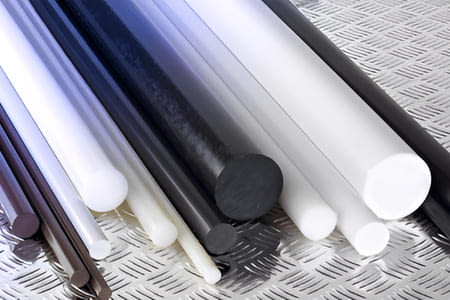
Plastic materials can be classified into three main types: thermoplastics, thermosets and elastomers. The main difference between them is their behaviour at high temperatures. Each one reacts differently.
In this post, we will tell you everything you need to know about thermosets.
In this post, we will tell you everything you need to know about thermosets.
What is a thermoset?
It is a type of polymer that, due to its properties, can only be melted down once. Unlike thermoplastics, once a thermoset has melted, cooled and has a defined shape, it would burn if heated up again. When high temperatures are applied to this material, the molecules become permanently bonded.
Although thermosets cannot be remelted or remoulded, they can undergo machining processes. Moreover, this type of polymer has very positive qualities that other types of thermoplastics cannot provide.
Although thermosets cannot be remelted or remoulded, they can undergo machining processes. Moreover, this type of polymer has very positive qualities that other types of thermoplastics cannot provide.
What are the qualities of thermosetting plastic?
- Its thermosetting properties make it a very resistant material, and therefore it is highly durable.
- It has a high thermal stability, so it can withstand very high temperatures
- It is a very rigid material that cannot be moulded, which prevents deformation once the shape has been established.
- Thermosetting plastic has both electrical and thermal insulating properties.
- Despite its resistant properties, it is a very lightweight material. This is an advantage in its technical applications.
Thermoset plastics, due to their properties, can be used for many things, and in some cases act as a substitute for metal. Currently, we can find thermosets in a wide range of industries, such as the automotive industry, construction industry, the electrical industry or for more everyday purposes such as household goods or cosmetics.
Some examples of thermosetting polymers are polyurethane, phenol, polyester resins, epoxy resins, melanin, among others.
In summary, the main difference between the three types of plastic materials is that thermoplastics, once melted, shaped and cooled, can then repeat this process. Whereas thermosets are rigid and cannot be remelted. And finally, the plastic called elastomer is a stable plastic material that, when deformed, tends to return to its initial state and can rarely be remelted, except in specific cases.
In the near future, we'll tell you everything you need to know about elastomers, see you in the next blog!
This is just a brief look at the most important properties of thermosetting plastics. If you need further information on any of these aspects, see the engineering plastics on our website, or contact us. We will be happy to help you.







